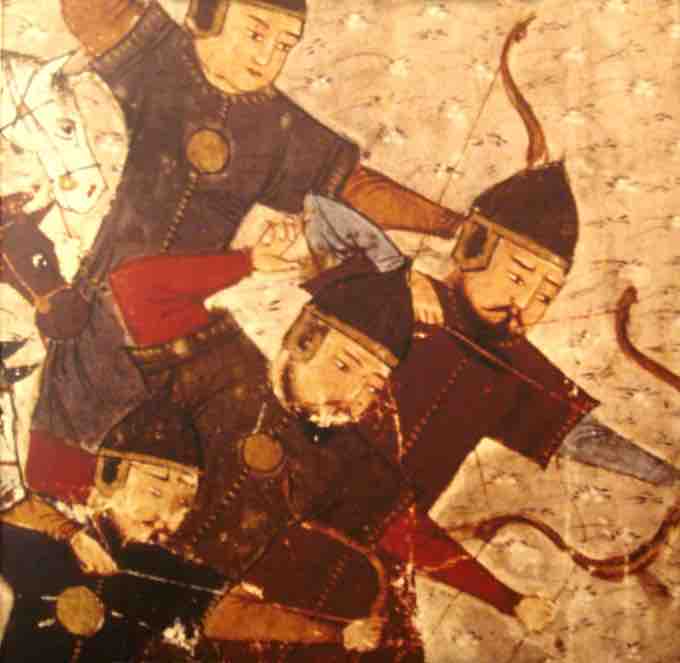Book painting in the late medieval Islamic world reached its height in Persia, Syria, Iraq, and the Ottoman Empire. The art form blossomed across the different regions and was inspired by a range of cultural reference points. The evolution of book painting first began in the 13th century, when the Mongols, under the leadership of Genghis Khan, swept through the Islamic world. Upon the death of Genghis Khan, his empire was divided among his sons and dynasties formed: the Yuan in China, the Ilkhanids in Iran, and the Golden Horde in northern Iran and southern Russia.
The Ilkhanids were a rich civilization that developed under these "little khans" in Iran. Architectural activity intensified as the Mongols became sedentary yet retained traces of their nomadic origins, such as the north-south orientation of buildings. Persian, Islamic, and East Asian traditions melded together during this period, and a process of "Iranisation" took place, in which construction according to previously established types, such as the "Iranian plan" mosques, was resumed.
The art of the Persian book began under the Ilkhanid dynasty, and was encouraged by aristocratic patronage of large illuminated manuscripts such as the Jami' al-tawarikh by Rashid-al-Din Hamadani . Islamic book painting witnessed its first golden age in the 13th century, mostly within Syria and Iraq. The tradition of the Persian miniature developed during this period, and strongly influenced the Ottoman miniature of Turkey and the Mughal miniature in India. Because illuminated manuscripts were an art of the court, and not seen in public, constraints on the depiction of the human figure were much more relaxed and the human form is represented with frequency within this medium.
Influence from the Byzantine visual vocabulary (blue and gold coloring, angelic and victorious motifs, symbology of drapery) was combined with Mongol facial types seen in 12th-century book frontispieces. Chinese influences in Islamic book painting included the early adoption of the vertical format natural to a book. Motifs such as peonies, clouds, dragons, and phoenixes were adapted from China as well and incorporated into manuscript illumination.

Mongol soldiers, in Jami al-Tawarikh by Rashid-al-Din Hamadani, 1305–1306
The Jāmiʿ al-tawārīkh is a work of literature and history, produced by the Mongol Ilkhanate in Persia. The breadth of the work has caused it to be called "the first world history" and its lavish illustrations and calligraphy required the efforts of hundreds of scribes and artists.
The largest commissions of illustrated books were usually classics of Persian poetry, such as the Shahnameh. Under the rule of the Safavids in Iran (1501 to 1786), the art of manuscript illumination achieved new heights, the most noteworthy example of this is the Shahnameh of Shah Tahmasp, an immense copy of Ferdowsi's epic poem containing more than 250 paintings.
The Court of Gayumars, from the Shahnameh of Shah Tahmasp, c. mid 1530s
Illuminated manuscripts of the Shahnameh were often commissioned by royal patrons.
The medieval Islamic texts called Maqamat, copied and illustrated by Yahya ibn Mahmud al-Wasiti, were some of the earliest "coffee table books. " They were among the first texts in Islamic art to hold a mirror to daily life, portraying humorous stories and showing little adherence to prior pictorial traditions.
In the 17th century a new type of painting developed based around the album (muraqqa). The albums were the creations of connoisseurs who bound together single sheets containing paintings, drawings, or calligraphy by various artists, sometimes excised from earlier books and other times created as independent works. The paintings of Reza Abbasi figure largely in this new form of book art, depicting one or two larger figures, typically idealized beauties in a garden setting, often using the grisaille techniques previously used for background border paintings .
The Mughals and Ottomans both produced lavish manuscripts of more recent history with the autobiographies of the Mughal emperors and more purely military chronicles of Turkish conquests. Portraits of rulers developed in the 16th century, and later in Persia, then becoming very popular. Mughal portraits, normally in profile, are very finely drawn in a realist style, while the best Ottoman ones are vigorously stylized. Album miniatures typically featured picnic scenes, portraits of individuals, or (in India especially) animals, or idealized youthful beauties of either sex.
Masterpieces of Ottoman manuscript illustration include the two "books of festivals," one dating from the end of the 16th century and the other from the era of Sultan Murad III. These books contain numerous illustrations and exhibit a strong Safavid influence, perhaps inspired by books captured in the course of the Ottoman-Safavid wars of the 16th century.